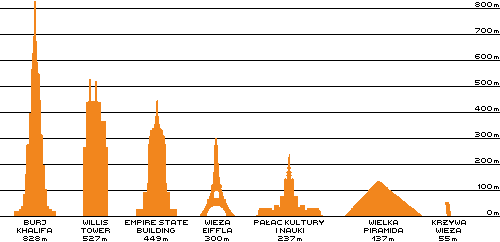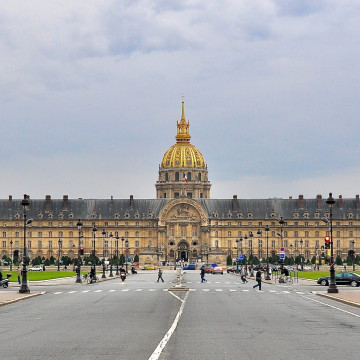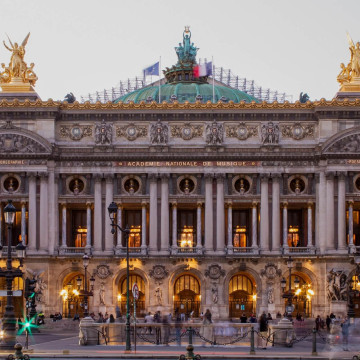Musée d'Orsay (Paris) - French art museum
Where is located Musée d’Orsay?
Address of Musée d’Orsay is 62 Rue de Lille, Paris, France
show on map
When was built Musée d’Orsay?
Built date of Musée d’Orsay is 1898 - construction begins
1900 - completion of construction

Facts, informations and history of Musée d’Orsay
The Musee D'Orsay is a French art museum located adjacent to the River Seine in Paris.
Originally on the site of the current structure was the Palais d'Orsay, which was burned to the ground during the Commune revolt of 1871. In 1900, a railway station was built in anticipation of the World's Fair to best present the city of Paris to the world. It was to be the world's first station capable of running electric trains.
Gare d'Orsay was the headquarters of France's southwestern rail network from 1900 to 1939, but became obsolete as the shorter platforms could no longer accommodate the new longer trains.
A plan to demolish the station and erect a hotel complex in its place was approved in 1970, but later cancelled.
In 1978, the building was listed as a historic monument and thus its demolition was prevented.
The building was also listed as a heritage site.
The building was finally closed completely on New Year's Day 1973, at which time the hotel within the station was also closed.
By 1975, the management was considering turning the station into a museum to showcase French art from the mid-1800s to the present day. Two years later, President Valéry Giscard d'Estaing took the official initiative to redevelop the station. Two years later, President Valéry Giscard d'Estaing took the official initiative to redevelop the station.
Six teams competed in an organised competition to design the museum building. The ATC Architecture office was chosen to design the museum, which included three architects, Pierre Colboc, Renaud Bardon and Jean-Paul Philippon. The museum's design was a major success.
The former Gare d'Orsay railway station has been transformed into a museum. It was inaugurated on 1 December 1986 by President François Mitterrand, and opened to the public on 9 December.
The museum's exterior and exterior were opened to the public on 9 December.
The exterior of the museum is a massive stone façade with a huge clock that retains the shape of typical railway stations; when you step inside the museum, you are struck by the beauty of its interior.
In 1981, the Italian architect Gae Aulenti was chosen to carry out the metamorphosis of the Orsay railway station. She was entrusted with the task of designing the interiors, including the internal layout, decoration, furniture and furnishings of the museum. However, her interior design for the Musée d'Orsay caused controversy.
Italian architect Gae Aulenti eventually designed the museum's interior. The former hall at the train station has been transformed into the museum's main artery, with a large glass canopy serving as the main entrance. The museum's main entrance is the main hall.
The halls of the museum are spread over three levels, which are served by six lifts and 10 staircases. Exhibition spaces, galleries and other facilities are spread over these three levels. They include the Amont pavilion, the glass walkway, the bookshop, the auditorium, the museum restaurant and the Café des Hauteurs.
Since 1939, the station has had many uses, serving as a postal centre, a film set, housing the Renault-Barrault theatre, the halls of the Drouot auction house, and used to transport World War II prisoners of war.
The museum boasts an extensive collection of paintings from the period between 1848 and 1914, with famous works by painters such as Monet, Renoir, Van Gogh, Degas, Seurat and Gauguin. It currently holds around 500 Impressionist paintings and nearly 1,100 Post-Impressionist masterpieces.
The Musée d'Orsay houses one of the finest clocks in the world, which once served as a railway station clock.
The museum was refurbished between 2009 and 2011 to improve the galleries, exhibition space and circulation. The museum has been renovated to improve its galleries, exhibition space and circulation.
The building is 31.98 metres high, 187.99 metres long and 74.98 metres wide. The main hall is 138 metres long, 40 metres wide and 32 metres high. The main hall is 138 metres long, 40 metres wide and 32 metres high.
In the square in front of the Musée d'Orsay, you can see 6 bronze sculptures depicting the continents of the world. They are by respectively: South America by Aimé Millet, Asia by Alexandre Falguière, Oceania by Mathurin Moreau, Europe by Alexandre Schoenewerk, North America by Ernest-Eugène Hiolle, and Africa by Eugène Delaplanche.
12,000 tonnes of metal were used to build the railway station, which is more than was used to build the Eiffel Tower.
To brighten up the interior, the building has as much as 35,000 square metres of glass.
The museum receives around 4 million visitors annually.
Architect of Musée d’Orsay
How many meters have Musée d’Orsay?
Height of Musée d’Orsay is 187.99 meters high


Construction/building type
Building Musée d’Orsay is of type Museum
Architectural style
Architectural style of Musée d’Orsay is Modern, Beaux-arts
Modern architectural style is a style characterised primarily by simple and regular forms, a lack of ornamentation and the use of modern building materials. It is significantly different from other architectural styles, such as Baroque, Gothic or Renaissance, where more complex forms and rich ornamentation predominated. ... czytaj więcej.
Practical informations

What is the cost of entry for Musée d’Orsay?
Tickets for Musée d’Orsay are available at the following prices and variants:
- Museum admission:
- - adults: €16
- - children under 18 and EU citizens under 26: free
- * free admission on the first Sunday of each month
At what times is open Musée d’Orsay?
Musée d’Orsay is open or accessible to the public on the following dates and times:
- Tuesday, Wednesday, Friday, Saturday, Sunday: 9:30 - 18:00
- Thursday: 9:30 am - 9:45 pm
- Closed every Monday, 1 May and 25 December.
Other names
The building is also known by other common names or in the original language, i.e. Gare d'Orsay
Official website
The official website of the building, where up-to-date information can be found, is https://www.musee-orsay.fr/en
Photo gallery Add photo
Location on map / How to get there

























Comments to Musée d’Orsay (1) Average rating: 5 Add comment / Rate building
Based on 1 comment